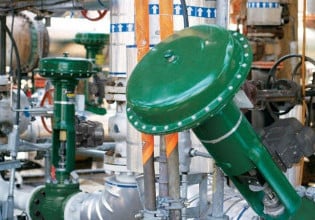Using Weather Data to Optimize High-Voltage Power Line Capacity
Two companies combine weather and sensor data to boost transmission capacity by 30%. Here’s how the technology works on high-voltage power lines.
Norwegian sensor provider Heimdall Power and Switzerland-based weather intelligence firm Meteomatics have shared the results of a three-year partnership to monitor and forecast the capacity of high-voltage transmission lines. With an average 30% increase in capacity across the pair’s European projects, the combined technologies enabled transmission system operators (TSOs) like Swissgrid, Austrian Power Grid, and TenneT to tap into all available capacity on their existing power lines.
Heimdall’s autonomous drone mounts a Neuron sensor on a 66 kV high-voltage power line. Image used courtesy of Heimdall Power
Today, many power lines operate without real-time insights into capacity changes. Grid-enhancing technologies, such as dynamic line rating (DLR) hardware and software, offer continuous updates on transmission capacity, allowing grid operators to efficiently shift power to underutilized lines—thus unlocking the grid’s full transmission capacity. The partnership between Meteomatics and Heimdall Power builds on the DLR concept, forming a solution based on real-time capacity and weather updates.
Utilities are looking to optimize their capacity as global electricity demand is projected to jump by about one-third to three-quarters by 2050, according to the U.S. Energy Information Administration, with renewable and nuclear sources claiming as much as two-thirds of generation. As more solar panels and wind turbines join the grid, dispatchable resources like coal and natural gas are needed to offset renewables’ intermittent generation. Conventional fossil fuel plants can increase or reduce output quickly based on demand.
Battery storage systems can also address gaps in renewable supply and demand. Still, new projects typically take years (even up to a decade) to move through the planning and approval stages to construction and interconnection. In the meantime, utilities and TSOs are increasingly motivated to maximize the infrastructure they already own and operate.
Working within the existing power grid means predicting weather’s influence on sudden energy demand and consumption surges—a key selling point of Meteomatics’ and Heimdall Power’s combined solution.
Optimizing Power Line Capacity With Weather Data
Meteomatics’ application programming interface (API) provides more than 1,800 weather data parameters informed by two dozen models. The database covers everything from wind direction to direct and global radiation to temperature readings by height, an oscillation index for power lines, and wind speed for different turbine specifications.
For example, the API contains over 1,000 wind turbine models with various installed capacities. The list ranges from Vestas’ small-scale 65 kW v16-55 turbines (with a 78-foot hub height) up to Windtec’s 10,000 kW, 410-foot turbines. For solar projects, Meteomatics’ API can track panel tilt and orientation to maximize utilization, among other crucial data points.
Meteomatics’ technology predicts future high-voltage power line capacity based on temperature data. This metric is crucial because the carrying capacity of electric power cables declines as ambient temperature rises. The data also gauges the expected impact of weather damage like icing, detects and prevents faults, and anticipates heating or cooling consumption based on seasonal demand spikes.
A time series compares installed capacities, tilts, and directions for solar panels. Image used courtesy of Meteomatics
The platform provides more than 1,640 daily updates and allows downscaling using topographic maps with a 90-meter resolution to improve hyperlocal accuracy. This means points are calculated every 295 feet, and weather data scales down accordingly.
While Meteomatics focuses on weather and climate data, Heimdall’s physical and virtual sensors enable real-time grid capacity monitoring, allowing system operators to manage power transmission and distribution more efficiently. Previously, in 2021, the pair teamed up on a project resulting in a 25% increase in average transmission capacity for European partners. Today, that number has grown to 30%, prompting the companies to bring their technology to the U.S. market.
Combining Weather Data With Sensors Mounted on Lines
Heimdall Power’s spherical Neuron sensors gauge a transmission line’s real-time temperature, current, and angle—offering insights on damage from ice storms, hurricanes, and other severe weather events. The sensors are installed on live high-voltage power lines using a hot stick or autonomous drone system, which only takes a few minutes.
Neuron sensors can support 0 to 550 kV lines and operate with currents ranging from 0 to 3000 A, line frequencies from 16 to 60 Hz, and -40 to 248ºF temperatures.
Heimdall Power’s Neuron sensor monitors high-voltage power lines. Image used courtesy of Heimdall Power
The sensor data is then processed through Heimdall’s software platform, which features other capacity-enhancing functions like asset health monitoring, fault detection, and line elongation.
Video used courtesy of Heimdall Power
Combined with precision weather and climate data from Meteomatics, Heimdall’s solution will now be deployed on U.S. power lines. The company has secured a few domestic contracts this year, including one using DLR technology to identify additional transmission capacity across Great River Energy’s grid in Minnesota.










Electric power technology is developing so fast